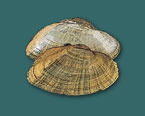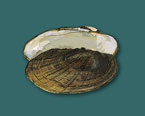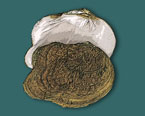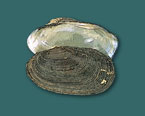
Mussels, like their salt water counterparts, oysters, create pearls. When a bit of foreign matter lodges in a mussel, the animal uses its nacre—the same material it uses for shell building, to reduce the irritation by coating the offending object. The results are luminous, glamorous and can be very rare.
BIG AS FILBERTS
Pearls have always been valued. Hernando Desoto reported that the local
tribes of Americas southeast were adorned with pearls “as big as filberts”
when he passed through in the1540’s. As La Salle descended the Mississippi
in 1618 he noted pearls possessed by the local inhabitants. He was
able to trade for 14 of them, exchanged for “a mean little boxwood
comb.” At archaeological sites throughout the eastern United States,
huge caches of pearls have been unearthed, over sixty thousand of them
were excavated from a mound in Ohio’s Little Miami Valley. It’s little
wonder given the native inhabitants close and prolonged association
with the great mussel beds lining our rivers, that pearls would play
an important role in their lives as well.
THE PEARL RUSH IS ON
The modern story of pearls in North America gets
interesting in 1857. A local carpenter near Patterson, New Jersey is
idlely dispatching mussels on a small stream called Notch Brook. Inside
one -- that great potential -- a large pearl over a half an inch across,
light pink in color and perfectly round. The “Queen Pearl” as it came
to be known, made headlines. Tiffany and Company of New York paid $1500
for the pearl, a life changing sum in 1857. Tiffany’s later sold the
pearl to the Empress of France, an impressive journey from a lowly New
Jersey stream. Unfortunately news of the find decimated the mussel beds
of New Jersey. The first “pearl rush” was on. Like the gold rushes in
the west, the lure of easy money and a potential to change your life
were hard to resist. After the news of a valuable find went out, the
streams and rivers quickly filled with fortune seekers. It was not good
news for the mussels. In the 1860’s the craze took hold on Ohio streams.
News of the huge caches found at local archaeological sites had just
gone public. Wisconsin was next. Beautify colored pearls triggered the
rush in the 1880s. Eight years later nearly $300,000 dollars of
pearls had been found, but the mussels in Wisconsin streams were nearly
exterminated. In backwoods Arkansas, the locals were not aware of the
incredible value of pearls, regarding them as play things for the children.
Savvy buyers from St. Louis and Memphis quickly changed their minds.
The great White River pearl rush was on. Dubbed the “Arkansas Klondike”
by national newspapers, the pearl rush created excitement around the
country near the turn of the century. Again, valuable pearls were discovered,
several selling for over one thousand dollars. But the cost to the mussel
fauna was incalculable. Several species were doomed to extinction after
this pearl craze ran its course.

![]()
Link to New York Times article - 1902
The potential held within each mussel has a darker side
for the pearl seeker. There is also very good potential, a great potential
in fact, that the mussel will not contain a pearl. For the fortune seeker it’s
a simple waste of effort as they move to the next bed. It is more consequential
for the mussels. Millions died on the off chance that some lucky stiff might
beat the odds and find his pearl. But far away from the mussel beds of North
America, on a small lake near Kyoto, Japan, one man was working to change those
odds.
MIKIMOTO CHALLENGES NATURE
Kokichi Mikimoto, the son of a Japanese noodle maker
was convinced finding pearls in oysters and freshwater mussels didn’t
have to be left to chance. They could be planted in the mussel, and harvested
like an agricultural crop. For decades he threw himself into his quest,
researching various methods of inserting foreign matter into mussels
and oysters hoping to induce the mollusks to create his prize, a perfectly
round pearl. According to the promotional material produced by his very
successful company, Mikimoto achieved his dream on July 11, 1893.
“In the company of his wife Ume, he raised one of the bamboo oyster baskets
out of the water, opened one of the oysters, and there, inside the shell,
he discovered a shining pearl that he had cultured. This was the first
time in history a human being had ever created a pearl.” He is reported
to have said “I would like to adorn the necks of all the women of the
world with pearls” It was a prophetic remark. The cultured pearl industry
is doing just that. It has taken the chance and rarity out of finding
a pearl, in the process it has made pearls accessible to people throughout
the world.
The image of Mikimoto is romantic one, standing on the shores of Japan’s
Lake Biwa in his top hat and frock coat, realizing that he had, in
the words of his company’s promotional material; “succeeded in culturing
pearls only after challenging Mother Nature.” He also made a fortune
in the process. Mikimoto became a well known brand in fashion circles
worldwide, the Japanese dominated the cultured pearl industry for nearly
a century. But what does this Asian sidebar to do with North American
mussels? The story comes full circle, back to the rivers of North America.

Mikimoto experimented with a wide variety of foreign matter
to culture his oysters, gold and silver beads, bits of live mantle tissue
from other mussels, all sorts of things. The experiments went on for decades.
But the best material for culturing pearls turned out to be small spheres
of freshwater mussel shell. At the heart of every cultured pearl, there’s
a bit of North American natural history, coated in layers of nacre. Enter
the latest phase of our own history of mussel harvest; we are currently
shipping tons of mussel shells to Asia for the cultured pearl industry.
Again it’s a destructive process for the mussels, a ton of shell only process
about 40 to 60 pounds of nuclei. It’s estimated that almost 90 percent
of the weight of a cultured pearl might be comprised of North American
shell.
Now China has entered the cultured pearl market, and they’ve done so with
amazing efficiency. They’ve surpassed the Japanese in production, using
new techniques that effectively mass produce pearls in freshwater mussels;
pearls that are perfectly round, “all-nacre” and are indistiguable from
“natural’ pearls by the most disseminating gem experts. While the rarity
of these pearls will diminish, they’re beauty and luster remains, and again
at the heart of each, a North American mussel.






